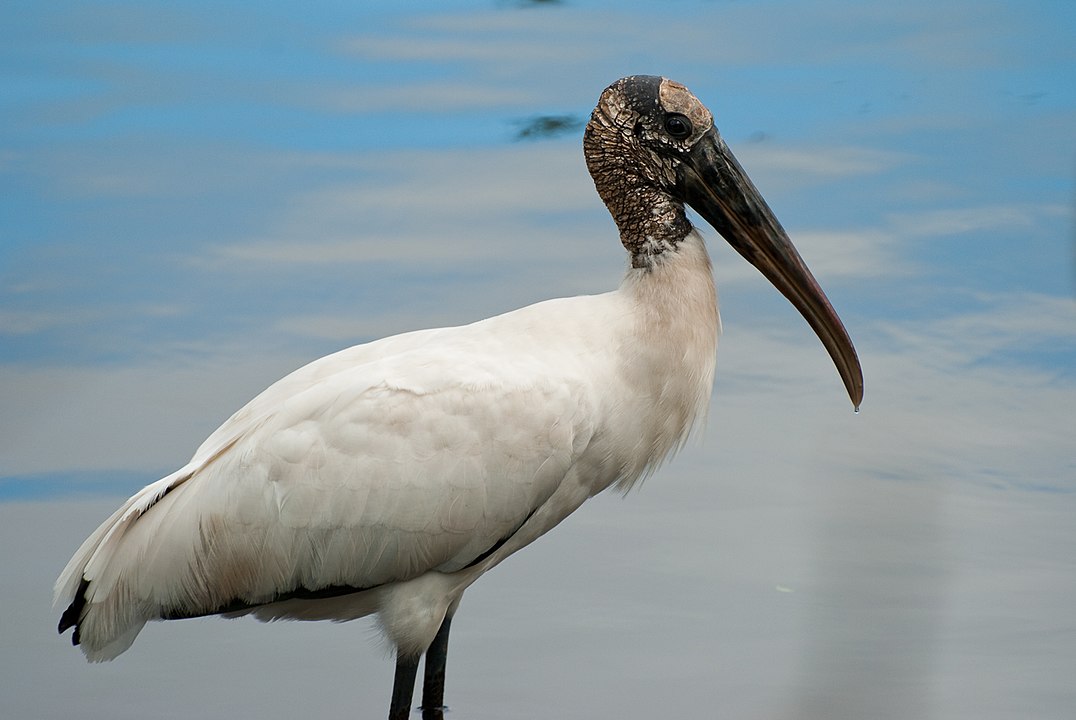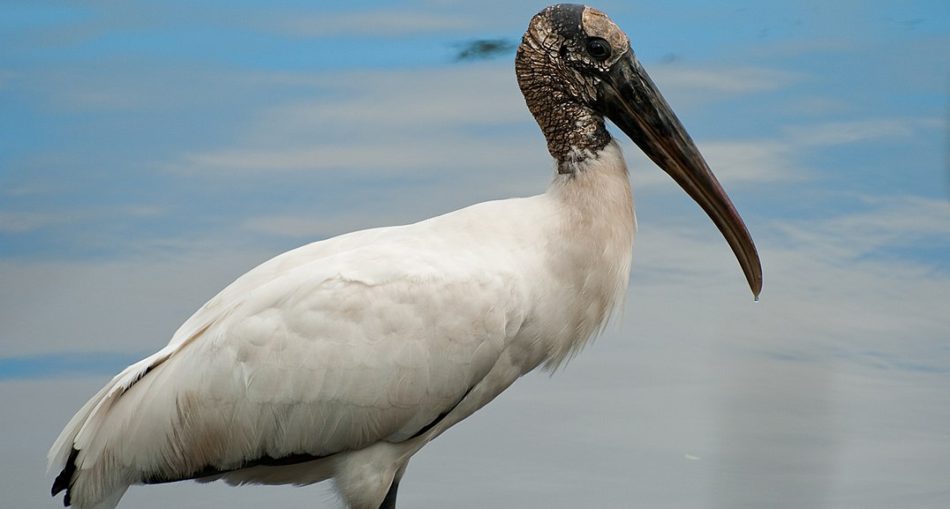The Wood Stork is native to the tropics and subtropics of the Caribbean, Central America, North America and South America in countries like Guyana and Argentina. In Guyana, you can find these tall, long-legged Wood Storks nesting in the trees of mangrove forests. The birds prefer living near waterways, where they wade and hunt for fish. They live most of their lives in one area, except for those in the United States North Carolina which migrate to North Carolina, Mississippi and Alabama after breeding in South Carolina, Georgia, and Florida. Previously mistaken for an ibis, the Wood Stork was called the wood ibis. The scientific name of the Wood Stork is Mycteria americana but it is fondly referred to as flinthead and ironhead.

The Wood Stork -Photo By Johnathan Nightingale – originally posted to Flickr as Wood Stork, Profile, CC BY-SA 2.0, https://commons.wikimedia.org/w/index.php?curid=10124941
Description Of The Wood Stork
The male adult Wood Stork weighs about five to seven (5-7) lb, while its female counterpart weighs four to six (4-6) lbs. Both birds reach heights anywhere from thirty-three to forty-five (33-45) in and have wingspans of fifty-five to seventy-one (55–71) in. Their bills are long and black. The plumage of the Wood Stork is primarily white with its black primaries, secondaries, and tail with purple-green iridescence. The rest of its body does not have any feather, including its head, neck and scaly skin which are all dark grey in colour. Legs and feet are also dark but toes turn pink during the breeding season. The immature birds have pale yellow bills with light grey heads and necks. The hatchlings have a grey coat which is replaced by a dense white down.
Scientific Classification Of The Wood Stork
- Kingdom: Animalia
- Phylum: Chordata
- Class: Aves
- Order: Ciconiiformes
- Family: Ciconiidae
- Genus: Mycteria
- Species: M. americana
Habitat Of The Wood Stork
The Wood Stork lives in both tropical and subtropical habitats with fluctuating water levels which facilitate breeding. These include mangrove forest, swamps marshes and streams. The bird inhabits the trees in these areas, surrounded by water or growing over bodies of water.
Diet Of The Wood Stork
The diet of the Wood Stork varies by season; during the dry season, the bird eats fish and some insects. On the other hand, during the wet season when fish is plentiful, half of its diet consists of fish, thirty (30) percent of crabs and the remaining twenty (20) per cent is made up of frogs, snails, and insects. The Wood Stork prefers large fishes compared to the small ones even in abundance.
The Wood Stork wades in shallow water, searching for movement. As soon as they touch a fish, they snap their bill shut.
Interesting Tip
- The bill-snapping reflex of the stork is the fastest reflex known in vertebrates.
Reproduction Of The Wood Stork
Breeding occurs around November to August, when fish is abundant and the water level drops, thus allowing enough food for the chicks. The Wood Stork builds its nest in the forks of large limbs of a tree. A tree can hold as much as twenty-five (25) nests since the species nests in colonies. Their nests are made of large, green twigs sticks and greenery which is added after the structure is done. A completed nest is about one (1) metre in size and a padded center of greenery around eleven (11) inches. The Wood Stork lays about three to five eggs, cream in colour about three inches (3) large. Both parents incubate the egg, starting immediately after the first egg is laid. After hatching the chicks weighs about sixty-two (62) g. They are taken care of by both parents who take turns foraging, brooding and guarding the nest. Hatchlings fledge anywhere from sixty to sixty-five (60-65) days after hatching. Wood Storks mature at four (4) years of age but do not successfully fledge until five (5) years old.
Interesting Tip
- The added greenery helps to insulate the nest.
8 Facts About The Wood Stork
- Wood Storks are attracted to lakes, streams and river edges as feeding grounds.
- The diet of the Wood Stork is relatively large; a bird of about two point five (2.5) kg daily consumes more than half a kg.
- Sometimes the Wood Stork leaves its nest during the night to forage during low tides, allowing them to avoid food competition of other birds.
- While they build their own nests, sometimes Wood Storks cooperate and take over nests of other birds, throwing out the chicks and eggs in under fifteen (15) minutes. In some cases, the Wood Stork waits until its mate returns then try to recover its stolen nest.
- In the first week of incubation parents only take short trips to drink, forage or collect more nesting material.
- Wood Storks never leaves their eggs unattended.
- Sometimes fighting of the adults results in the eggs breaking.
- Wood Storks are preyed upon by raccoons who climb their nests to eat the hatchlings and by alligators lurking below.
About The Wood Stork
Wood Storks are relatively large birds with good parenting instincts, taking great care of their young. They choose their homes based on food and location near water and breed as the season permits. The birds use their large bills to fish for food, snapping them up as soon as they find an unsuspecting prey. The Wood Stork can be spotted in flight above Karanambu Lodge or anywhere near water with their heads submerged in water, foraging for their favourite food – fish.







